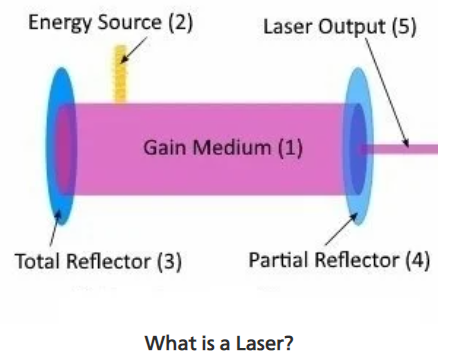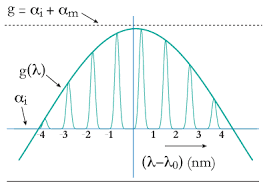
Laser diodes must meet two critical requirements to facilitate the lasing process. The first requires that, at a minimum, the laser cavity’s gain increases to the point that it reaches unity with the level of losses. This unity state is known as the gain threshold. If you missed it, read our previous blog, titled “Laser Diode Fundamentals: Diode Gain Threshold,” to get an in-depth understanding of this phenomenon. The second requirement is that there must be a longitudinal mode present inside the optical cavity, coinciding with the laser’s gain curve. This article explores precisely what longitudinal modes are and how they affect the laser diode‘s performance.
 All lasers must contain three key components: an active gain medium, a resonator cavity, and an excitation/pump source. To understand what longitudinal mode is and how it’s derived, we will focus solely on the resonator cavity, ignoring the gain medium and excitation/pump source. To further clarify our initial analysis, we will also assume that both mirrors in the resonator cavity are 100% reflective, effectively giving us what’s known as an “ideal resonator.” In the simplest case, the laser’s optical cavity is formed by two opposed plane (flat) mirrors surrounding the gain medium (a plane-parallel or Fabry–Pérot cavity). In this scenario, all light waves are trapped within the cavity, creating a standing wave as the light propagates and reflects between the two mirrors. For a better conceptualization, think of how guitar strings can sustain the same note or frequency, resulting from the wave propagating along the medium and reflecting off the string’s fixed ends (standing waves).
All lasers must contain three key components: an active gain medium, a resonator cavity, and an excitation/pump source. To understand what longitudinal mode is and how it’s derived, we will focus solely on the resonator cavity, ignoring the gain medium and excitation/pump source. To further clarify our initial analysis, we will also assume that both mirrors in the resonator cavity are 100% reflective, effectively giving us what’s known as an “ideal resonator.” In the simplest case, the laser’s optical cavity is formed by two opposed plane (flat) mirrors surrounding the gain medium (a plane-parallel or Fabry–Pérot cavity). In this scenario, all light waves are trapped within the cavity, creating a standing wave as the light propagates and reflects between the two mirrors. For a better conceptualization, think of how guitar strings can sustain the same note or frequency, resulting from the wave propagating along the medium and reflecting off the string’s fixed ends (standing waves).
Similarly, an infinite number of standing waves can exist inside this resonator cavity, but they all must have a node at the two mirrors. The allowed modes of the cavity are those where the mirror separation distance L is equal to an exact multiple of half the wavelength, λ:  , called the free spectral range, where c is the speed of light, n is the index of refraction, and L is the cavity length. , called the free spectral range, where c is the speed of light, n is the index of refraction, and L is the cavity length. |
 |
Given this quantization of suitable frequencies/wavelengths in the laser resonator cavity, we can see that an infinite number of modes can fit into the resonator, all with equal frequency spacing. These Fabry-Perot modes, as they’re called, heavily influence the laser’s spectral characteristics. However, no mirror is 100% reflective, and if they were, you couldn’t use them to generate a laser beam. A cavity with 100% reflective mirrors would block all transmission of light, making it impossible to output a usable beam. Since all practical resonator cavities will exhibit some loss at the mirrors, the Fabry-Perot modes can not be pure delta functions; rather, they have an inherent line width that varies based on their reflectivity percentage. A detailed analysis of the causes of this line broadening is beyond the scope of this blog post. However, the figure below illustrates the effects mirror reflectivity has on the mode structure.


You can acquire the specific, allowable spectral modes by superimposing the laser diode’s gain band on top of the Fabry-Perot cavity modes, as shown in the figure to the right. The laser can only produce these remaining modes (or wavelengths), referred to as the laser’s longitudinal modes. If a particular longitudinal mode’s gain is greater than the total cavity loss (the gain threshold), amplification of that mode is allowed, and lasing can occur. The interrelationship between gain threshold, gain bandwidth, and longitudinal mode spacing ultimately determines whether a diode operates as a single or multi-mode device. A laser is classified as ‘single longitudinal mode’ (SLM) when the gain threshold is significantly high, and the gain bandwidth substantially narrow, allowing for only one mode to lase. Conversely, a laser is classified as ‘multi-longitudinal mode’ (MLM) when the gain band is substantially broad and the threshold significantly low, allowing for many modes to lase at once.
Both multi-longitudinal mode and single longitudinal mode diode lasers have their inherent pros and cons. Multi-longitudinal mode diode lasers are typically more straightforward and cost-effective to produce, with the added benefit of generating much higher output powers, due to the larger number of modes. On the other hand, single longitudinal mode diode lasers have a much narrower bandwidth, making them more desirable for applications that require precise knowledge of the wavelength. However, these diode lasers typically produce much lower power and are more challenging to manufacture.
You now have a basic understanding of the fundamental principles underpinning the structure of longitudinal modes. Continuing our Laser Fundamentals series, the follow-up to this blog will examine a laser’s design to ensure that it operates with only a single longitudinal mode. In that article, we will cover both adding external optical elements to a traditional laser diode and modifying a laser diodes structure to allow only one mode to reach the gain threshold.
Here at RPMC Lasers, we have over 20 years of experience with diode lasers. With our knowledge and vast product portfolio, our Product Managers will assist you in narrowing down the ideal solution for your application. We also offer countless custom solutions, including laser diode packaging configurations with a wide range of integrated optics. If we don’t have what you need in our standard product lines, our laser experts will help you realize a custom solution. For more information about our wide variety of laser diodes you can click here, and for more information about laser diode fundamentals be sure to visit our Lasers 101 page.
Talk to one of our knowledgeable Product Managers today by emailing us at info@rpmclasers.com or Contact Us with the button below!
Have questions?

 SHIPS TODAY
SHIPS TODAY 